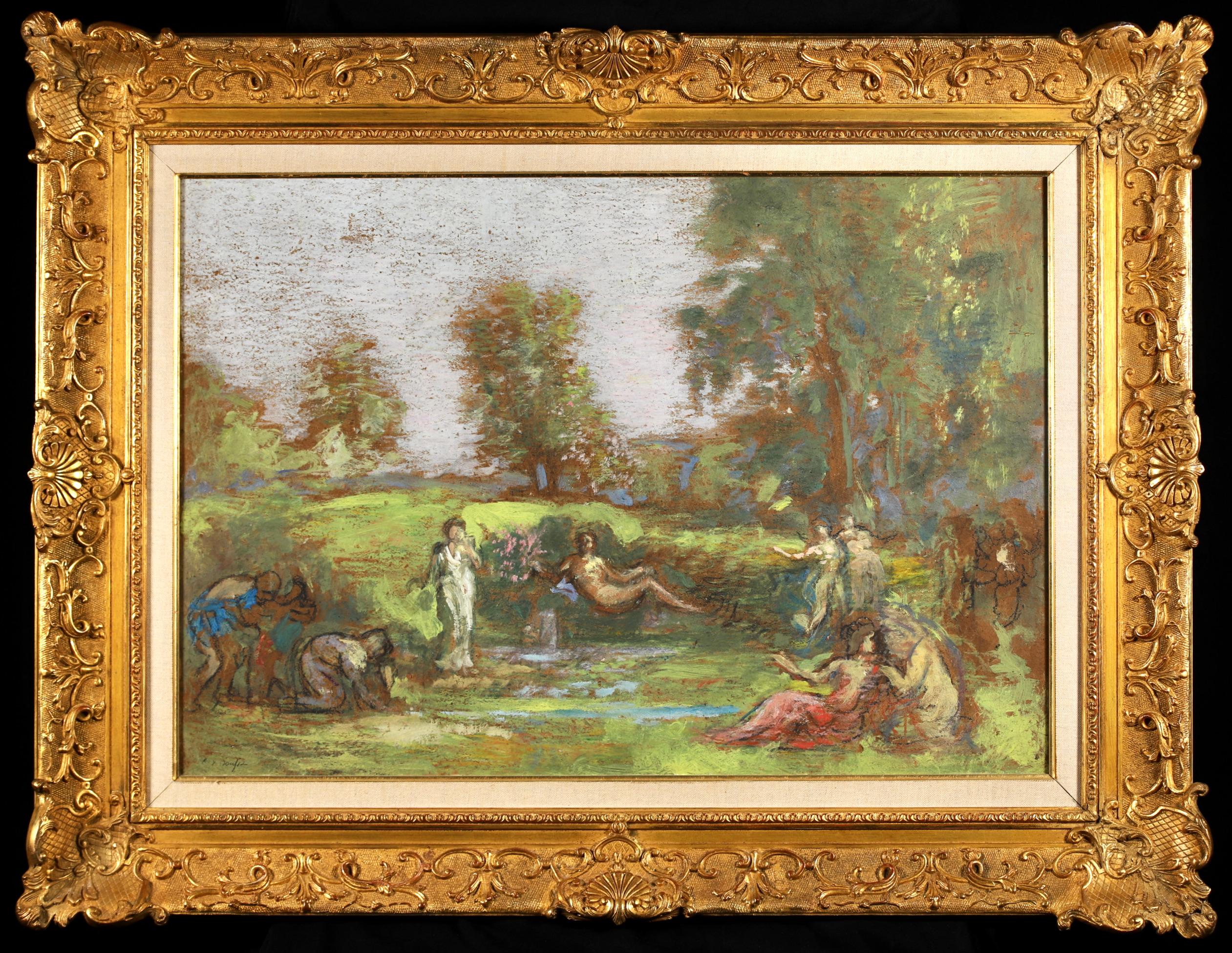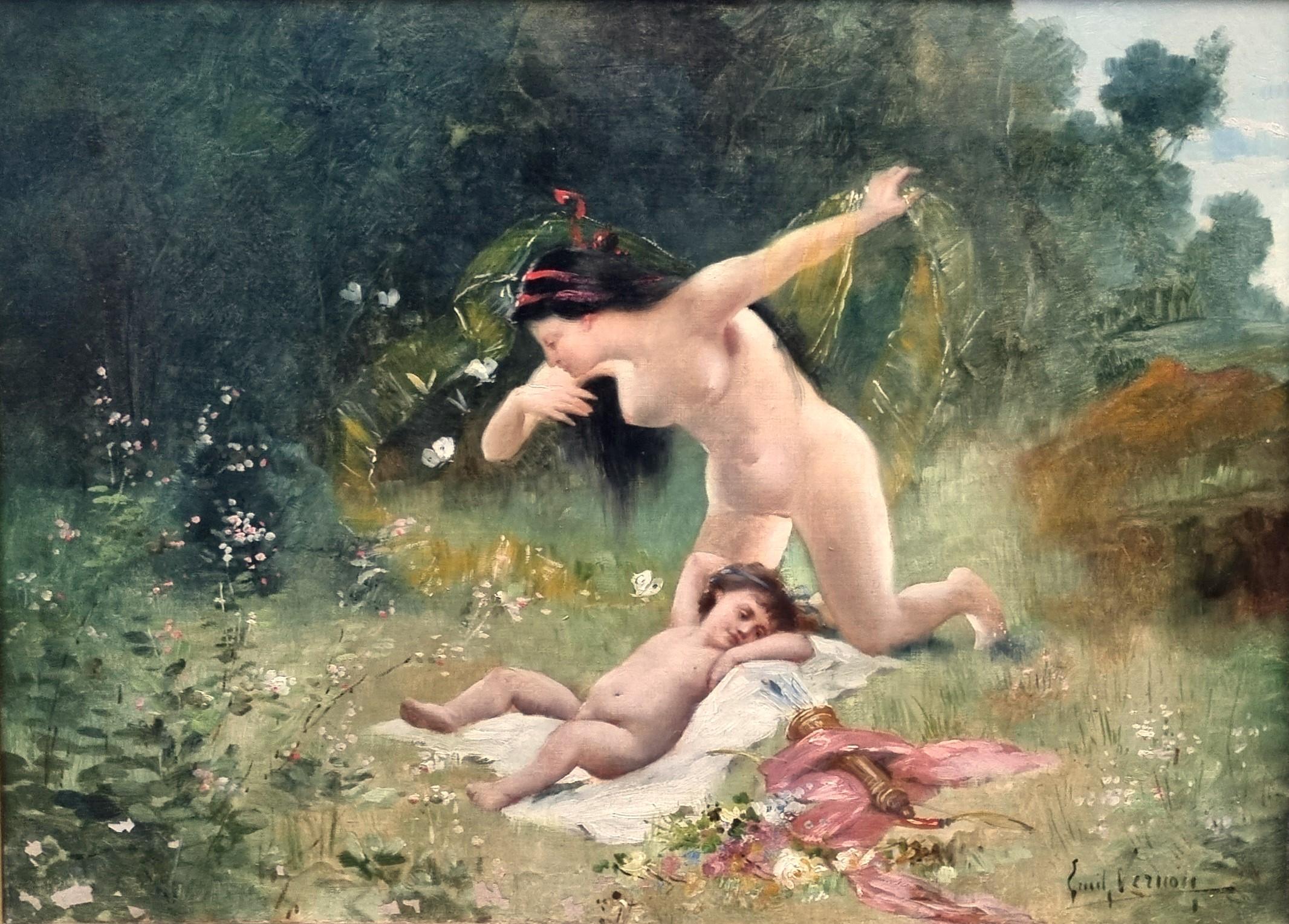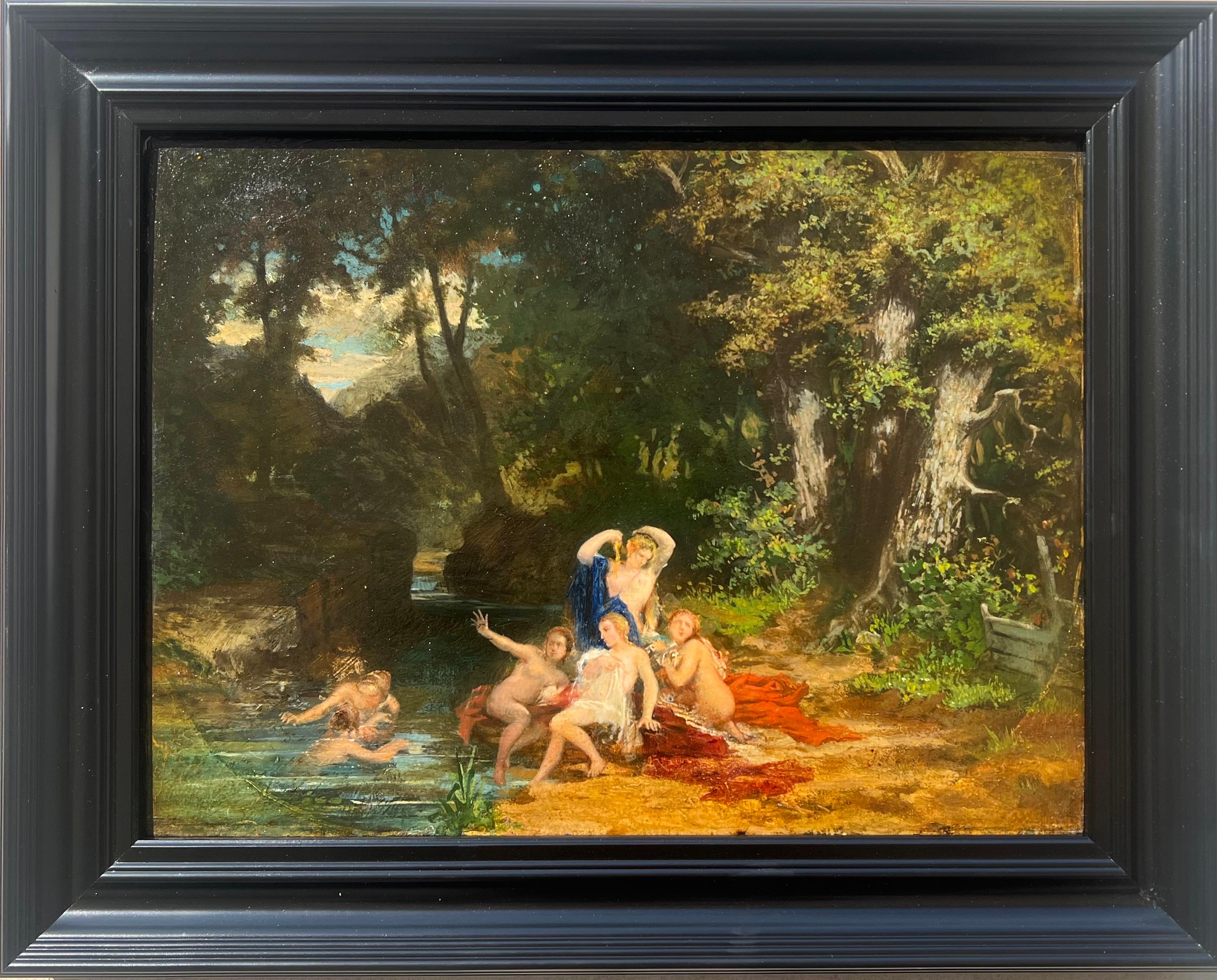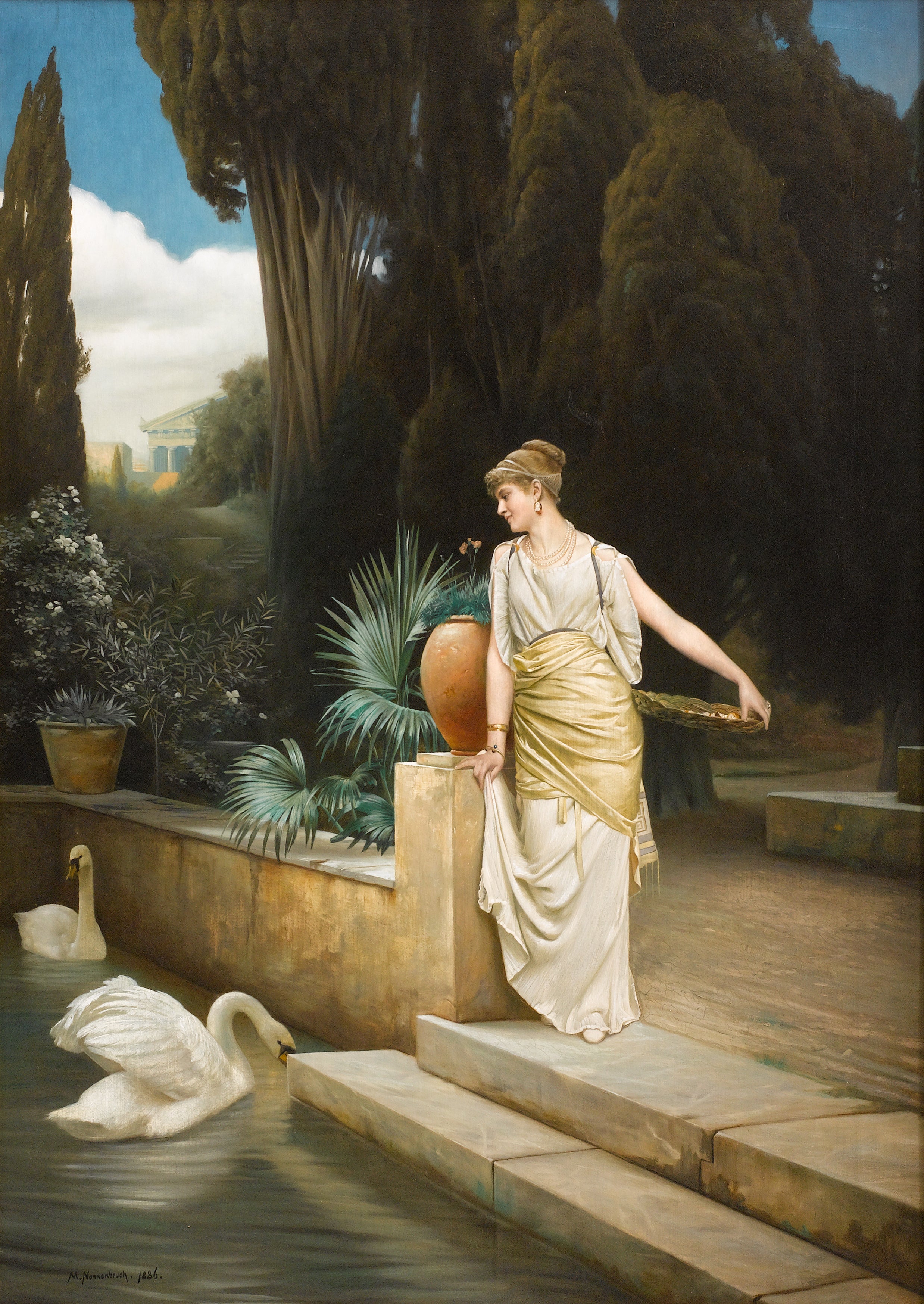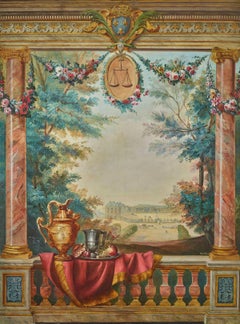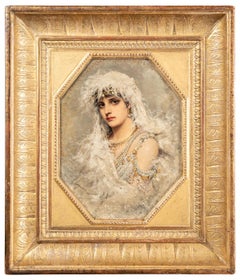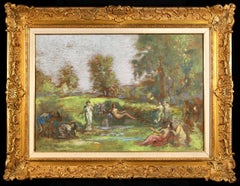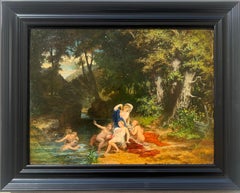Items Similar to Le rêve brisé
Want more images or videos?
Request additional images or videos from the seller
1 of 9
ADOLF GUDFAST WERNER Le rêve brisé1873
1873
$29,632.83
£22,191.02
€25,000
CA$41,471.65
A$45,470.40
CHF 23,744.28
MX$547,179.13
NOK 299,258.83
SEK 281,380.27
DKK 190,437.76
About the Item
In this enchanting painting by Adolf Gudfast (Gotthard) Werner, entitled "The Broken Dream", a young shepherd rests melancholically beside his faithful dog, facing a broken vase from Greek antiquity.
Cupid, recognizable by his wings and bow, stands nearby, accompanied by Sappho, the Greek poetess, and Euterpe, the muse of music. Bacchus, identifiable by his Thyrse and the ivy he holds, also emerges in the scene, followed by satyrs and nymphs, evoking a divine Greek world. This work captures the essence of the broken dream through a symbolic composition rich in mythology and emotion.
Biography :
Adolf Gudfast (Gotthard) Werner, born December 4, 1837 in Linköping, died February 20, 1903 in Rome, was a Swedish caricaturist and history painter.
He was the son of physician Henrik Werner and Ida Werner, née Gradman. His father, a regimental physician in Linköping, died in 1849, and his mother moved to Stockholm when he began his art studies. From 1857 to 1861, he studied at the Royal Swedish Academy of Fine Arts, where Georg von Rosen (a friend of Edouard Manet) was one of his fellow students.
While at the Académie, he was awarded the Meyerska Medal in 1859. In 1861, he moved at his own expense to Antwerp, where he studied at the Academy of Fine Arts. From Antwerp, he moved with his mother to Paris, where he studied with Émile Signol.
He then traveled to the south of France and Italy, where he nourished his palette with colors and shimmering lights inspired by Mediterranean landscapes.
In 1866, he moved to Seville, then to Rome in 1869, where he studied High Renaissance decorative painting.
In 1870, Queen Josefina awarded him a travel grant, enabling him to explore Europe.
Through Georg von Rosen, he was commissioned to paint a series of pictures for the Bolinder house in Stockholm, and returned to Sweden in 1876 to fulfill the order.
He continued his travels, spending 1881 in Florence and the following autumn in Bologna.
He returned to Sweden in 1883 to take part in a competition to decorate a mural in the vestibule of the National Museum. He settled for a time in Kalmar, but after receiving a prize for his proposal, he went to Egypt in 1884.After a few brief returns to Sweden, he remained in Italy until his death. He became a member of the Royal Academy of Fine Arts in 1868 and took part in the Academy's exhibitions in 1866, 1868 and 1877.
He took part in the Paris Universal Exhibition in 1889 and the Swedish Artists' Association Exhibition in Stockholm in 1898. A commemorative exhibition was organized by the Artists' Association in Stockholm in 1904. His work consists of religious motifs and history paintings.
About the Seller
No Reviews Yet
Vetted Professional Seller
Every seller passes strict standards for authenticity and reliability
Established in 2012
1stDibs seller since 2024
- ShippingRetrieving quote...Shipping from: Saint-Ouen-sur-Seine, France
- Return Policy
Authenticity Guarantee
In the unlikely event there’s an issue with an item’s authenticity, contact us within 1 year for a full refund. DetailsMoney-Back Guarantee
If your item is not as described, is damaged in transit, or does not arrive, contact us within 7 days for a full refund. Details24-Hour Cancellation
You have a 24-hour grace period in which to reconsider your purchase, with no questions asked.Vetted Professional Sellers
Our world-class sellers must adhere to strict standards for service and quality, maintaining the integrity of our listings.Price-Match Guarantee
If you find that a seller listed the same item for a lower price elsewhere, we’ll match it.Trusted Global Delivery
Our best-in-class carrier network provides specialized shipping options worldwide, including custom delivery.More From This Seller
View AllMalagasy life scenes
Located in Saint-Ouen-sur-Seine, FR
The present decorative frieze, signed by the Malagasy painter Georges Razanamaniraka, is organized around the central figure of an enigmatic and hypnotic dancer. The quasi-symmetrica...
Category
1920s Tribal Figurative Paintings
Materials
Oil
Vue du château de Versailles depuis la place d’Armes
Located in Saint-Ouen-sur-Seine, FR
Henry Tenré received a solid training in Gustave Boulanger and Jules Lefebvre’s studio at the Julian Academy from 1875 to 1885. Then he studied under the multi-medallist landscape pa...
Category
Early 1900s Academic Landscape Paintings
Materials
Oil
Fleur de Neige, Portrait de Mme Godillot
By Jan Van Beers
Located in Saint-Ouen-sur-Seine, FR
Fleur de Neige by Jan Van Beers, painted in July 1880, stands out for the delicacy of its depiction. This remarkable portrait depicts a woman dressed in a sumptuous white costume, ad...
Category
1880s Old Masters Portrait Paintings
Materials
Oil
You May Also Like
Fete Champetre - Symbolist Figurative Oil Painting by Ker Xavier Roussel
By Ker Xavier Roussel
Located in Marlow, Buckinghamshire
Signed symbolist oil on panel circa 1910 by French Les Nabis painter Ker-Xavier Roussel. This beautiful painting depicts nudes and figures dressed in robes in a wooded landscape.
Signature:
Signed lower left
Dimensions:
Framed: 31"x40"
Unframed: 23"x32"
Provenance:
JPL Fine Arts - London c. 1985
Ker-Xavier Roussel met Édouard Vuillard at the Lycée Condorcet, which they both attended. Together they visited Eugène Ulysse Napoléon Maillard's studio, where Roussel became acquainted with Charles Cottet, going on to study at the Académie Julian under Bouguereau and Jules Lefebvre. There, he became interested in the Synthetism promoted by Sérusier, following Sérusier's heeding of the line Gauguin had adopted in Pont-Aven. He joined the Nabis group. He and his friends form a link between the Impressionists - he knew Cézanne, Degas, Renoir and Monet - and the Fauves and Cubists.
In his earliest paintings, Roussel adopted a dark palette for Realist still-lifes. Later, his work bore the influence of Gauguin, Sérusier, the Nabis and Cézanne, in Intimist scenes painted in flat tints not yet clearly delineated. Their dull, saturated tones are reminiscent of Cézanne. In about 1900 he started painting mythological scenes full of nymphs and fauns and set in his home region of Île-de-France. After a bicycle trip in Provence with Maurice Denis, during which he met Cézanne, he lightened his palette, much taken by the cloudless skies below which he would now set the mythological and idyllic compositions which link him to Poussin and Corot. This wondrous, unreal world found its way into large-scale works, including the stage curtain of the Champs-Élysées theatre in 1913, a large Pax Nutrix for the Palais des Nations in Geneva and Dance for the Palais de Chaillot in 1937. He is best remembered for: Silenius' Triumph, Polyphemus, Diana, The Abduction of the Daughters of Leucippus. The nymphs and fauns of a mythology quite his own appear in clearings and woods from the outskirts of Paris, but the sun they rejoice in is Mediterranean. To capture the vibration of bright colours under a permanent sun, he later turned to pastels. He was more a Symbolist than a Nabi and signed himself K.-X. Roussel. He also produced lithographs.
He took part in exhibitions from 1891 with the Groupe des Vingt at le Barc de Bouteville's gallery in Brussels. Then he exhibited in Revue Blanche Painters ( Les Peintres de la revue blanche) in Paris; with the Nabis at Café Volponi in Paris; before World War I with Free Aesthetics in Brussels; from 1901 at the Salon des Indépendants and the Salon d'Automne; in the 1930s in Revue Blanche Painters ( Les Peintres de la Revue blanche) hosted in Paris by designer Bolette Natanson, the daughter of the Revue Blanche's owner. He took part in The Masters of Contemporary Art ( Les Maîtres de l'art contemporain) at the Musée du Petit Palais in Paris, and at the 1938 Venice Biennale and 1939 New York World Fair. He featured posthumously in Toulouse-Lautrec and the Nabis ( Toulouse-Lautrec et les Nabis) at Bern Kunsthalle; From the Revue Blanche ( Autour de la revue blanche) in the Galerie Maeght, Paris, and in Tokyo and Brussels. He had one-man shows in Paris before his death in 1944. Retrospectives were mounted in the 1960s in London and Bremen.
Museum and Gallery Holdings:
Geneva (Petit Palais): Haystacks on the Seaside
Paris (BNF): Training the Dog; Landscapes (engraving); Nymph and Faun (c. 1895, etching)
Paris (Louvre): Poject for a Screen (drawing)
Paris (MNAM-CCI): The Road (c. 1905); The Cyclops (1908); Venus and Cupid on the Seafront (1908); The Abduction of Leucippus' Daughters (1911); Pastorale (1920); Diana at Rest (1923); Portrait of Vuillard (1934)
Paris (Mus. d'Orsay): The Gate (pastel); Woman in Profile with Green Hat; In Bed; Félix Valloton...
Category
Early 20th Century Symbolist Figurative Paintings
Materials
Oil, Panel
"Allegorical Bacchic Scene"
Located in Edinburgh, GB
Allegorical Bacchic Scene
Unidentified Artist
19th Century (Neoclassical / Academic Style)
Oil on canvas
Framed: 129 x 467 cm
Canvas: 115 x 452 cm
No Signatured
Description
This ...
Category
19th Century Realist Landscape Paintings
Materials
Oil, Canvas
French academic painting Allegory Spring Love Child Belle Epoque end 19th
By Emile Vernon
Located in PARIS, FR
Emile VERNON
Blois, 1872 – Blois, 1920
Oil on canvas
44 x 61 cm (57 x 74 cm with frame)
Signed lower right “Emile Vernon”
Very beautiful 19th century frame in carved and gilded wood ...
Category
Late 19th Century Academic Landscape Paintings
Materials
Oil
$2,370 Sale Price
33% Off
19th century French Barbizon school painting Elegant group outdoors
By Jules Coignet
Located in Aartselaar, BE
19th century Barbizon painting "The nymphs bathing in a forest landscape"
The artist wonderfully captured this dreamy scenery with vibrant colours and assured brushstrokes, inviting...
Category
19th Century Impressionist Figurative Paintings
Materials
Panel, Oil
Le Sentier Idylle (the Happy Path)
Located in Austin, TX
"Le Sentier Idylle (the Happy Path)" by French Romantic painter Lazare Meyer (1847-1935)
51.5 x 31.5 in. - Oil Paint on Canvas
Framed
A luminous, two figure composition depicting a ...
Category
Mid-19th Century Romantic Portrait Paintings
Materials
Canvas, Oil
Price Upon Request
Max Nonnenbruch "Lady At The Swanlake" 1886 - Large German Symbolist Painting
By Max Nonnenbruch
Located in Worpswede / Bremen, DE
Max Nonnenbruch (1857 Viersen - 1922 Munich), student at the academy in Dusseldorf and Munich, went on study trips to Paris and Italy. Nonnenbruch, a representative of the German Symbolism, painted with preference idealized female figures. His works received international attention at the end of the 19th century and many work were sold to England, Scandinavia and America. Works by Nonnenbruch were exhibited since 1888 in the annual exhibitions of Munich, the Dresden Art...
Category
Antique 19th Century German Pre-Raphaelite Paintings
Materials
Canvas, Giltwood
